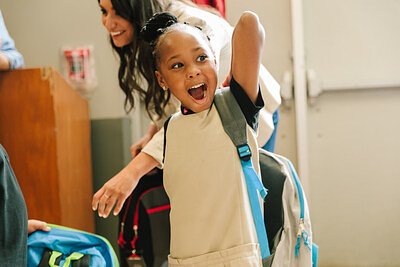
Beyond the Backpack: Nonprofit Fills Critical Supply Gap for Nation’s Neediest Schools
As school budgets tighten, one nonprofit is ensuring students in high-poverty districts have the essential tools to learn, going beyond backpacks to address systemic inequities.
Beyond the Backpack: Nonprofit Fills Critical Supply Gap for Nation’s Neediest Schools
By Debra Allen
As a new school year begins, the familiar scramble for pencils, paper, and backpacks occupies many families. But for schools serving high-poverty communities, the need extends far beyond these basics – and the resources to meet it are increasingly strained. The Kids In Need Foundation (KINF) is stepping up to fill that gap, providing critical supplies and addressing systemic inequities that leave millions of students underserved.
KINF recently announced a significant expansion of its efforts, aiming to distribute $43 million worth of resources this year to schools where 70% or more of students qualify for free or reduced-price meals. But the foundation’s work represents more than just a charitable gesture; it’s a response to a growing crisis in equitable access to education.
A Systemic Challenge
“The need is immense, and it’s not just about individual families struggling,” says a spokesperson for KINF. “We’re seeing a confluence of factors – tight school budgets, increasing economic pressures on families, and the lingering effects of the pandemic – that have created a perfect storm.”
Public school funding in the U.S. relies heavily on local property taxes, which means schools in lower-income districts are often drastically underfunded. This translates to outdated textbooks, limited technology, and, crucially, a shortage of basic classroom supplies. As a result, teachers frequently dip into their own pockets to provide materials, a practice that is unsustainable and exacerbates inequities.
“It’s heartbreaking,” explains a teacher from a high-poverty school district in the Midwest. “You want to give your students the best possible education, but it’s hard when you don’t have the tools. You end up spending so much of your own money, and it’s not a long-term solution.”
This issue extends beyond simple financial limitations. The lack of supplies can contribute to a cycle of disadvantage, creating a sense of shame and hindering a student’s ability to participate fully in class.
KINF’s Approach: Beyond the Basics
KINF's strategy focuses on providing ‘Teacher Resource Centers’ where educators can obtain free supplies, and its ‘Supply A Teacher’ program delivers boxes of core items directly to classrooms. But the foundation recognizes that simply distributing materials isn't enough.
“We’re not just about giving away pencils and paper,” explains the KINF spokesperson. “We’re about empowering teachers, leveling the playing field, and ensuring that every student has the opportunity to succeed.”
The foundation actively targets schools with the highest concentrations of poverty, recognizing that these communities face the most significant challenges. It also prioritizes providing a consistent and reliable supply of materials, understanding that sporadic donations are not enough to address long-term needs.
KINF's efforts are receiving praise from educators and advocates. “It’s a lifeline for our school,” says a principal from a school in a low-income community. “We rely on KINF to provide the materials our teachers need, and it makes a huge difference for our students.”
A Growing Network of Support
KINF isn’t alone in addressing this issue. Organizations like AdoptAClassroom.org, Boys & Girls Clubs of America, and local initiatives across the country are working to provide school supplies to students in need. However, the demand continues to outpace the available resources.
“There’s a real need for greater investment in public education,” says an education policy analyst. “We need to ensure that all schools have the resources they need to provide a high-quality education, regardless of their location or the socioeconomic status of their students.”
KINF is actively seeking to expand its network of corporate partners and individual donors to meet the growing demand. The foundation is also working to raise awareness of the issue and advocate for policies that support equitable access to education.
According to Charity Navigator, KINF boasts a “Great” rating of 95%, a testament to its financial health and commitment to transparency. The organization is committed to directing the vast majority of donations directly to program services, ensuring that funds are used effectively to support students and teachers.
The Ripple Effect of Support
The impact of providing school supplies extends far beyond the classroom. When students have the tools they need to learn, they are more likely to engage in class, achieve academic success, and develop a positive attitude towards education. This can have a ripple effect, leading to improved outcomes for individuals, families, and communities.
“It’s about more than just giving a child a pencil,” says the KINF spokesperson. “It’s about giving them hope, opportunity, and the chance to reach their full potential.”
The challenges facing schools in high-poverty communities are complex and multifaceted. But by providing essential resources and addressing systemic inequities, organizations like KINF are making a tangible difference in the lives of millions of students. As the new school year begins, their efforts offer a glimmer of hope for a more equitable and just future.
Ultimately, the story isn’t just about school supplies; it’s about a commitment to ensuring that every child, regardless of their background, has the opportunity to thrive. It’s a reminder that investing in education is investing in the future—a future where all students have the tools they need to succeed, and every community has the opportunity to flourish.
📝 This article is still being updated
Are you a relevant expert who could contribute your opinion or insights to this article? We'd love to hear from you. We will give you full credit for your contribution.
Contribute Your Expertise →